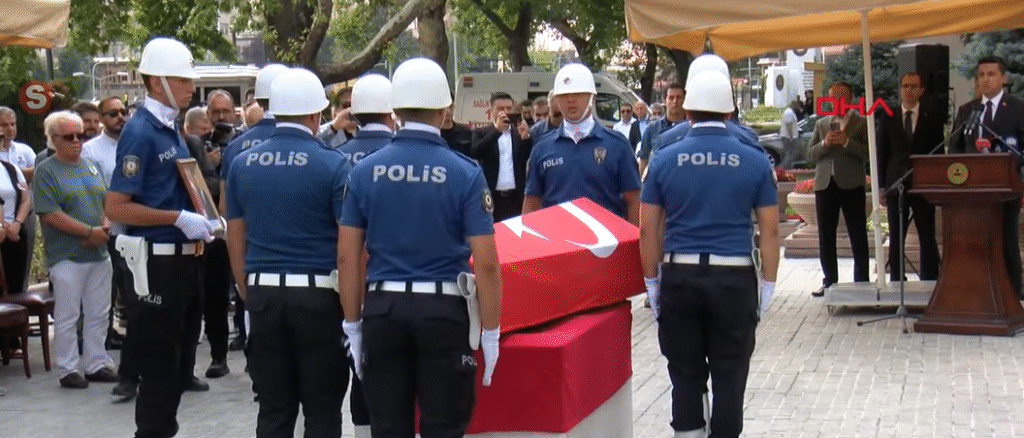Following the premature death of Erol Karaömeroğlu, Turkish public life has recently been engulfed in a tragic silence. His deadly accident on the Sivas-Malatya highway has left a significant void in both bureaucratic and civilian circles, despite his reputation for exceptionally effective governance in Sinop and Bitlis. Karaömeroğlu was 55 years old and making a significant contribution as the Ministry of Interior’s Chief Inspector when he was killed in a collision in Kangal.
His last night, by all accounts, was no exception to his orderly routine. While traveling the Sivas route with his wife Filiz and son Metehan, Karaömeroğlu’s car, registered 55 HN 055, collided with another car. The fact that the impact happened close to the Halep Bridge—an area not known for its high level of danger—makes the incident’s randomness all the more tragic. Emergency personnel arrived quickly. The Sivas Cumhuriyet University Medical Faculty Hospital received all injured parties. Karaömeroğlu could not be saved, though, despite the medical staff’s best efforts.
Civil servants like him were essential in maintaining public order and making sure that policies were followed, even in far-flung provinces, during the pandemic. In the last ten years, Karaömeroğlu’s name has become synonymous with composed, capable leadership. Transparent interactions with the local press and infrastructure development projects that were especially advantageous for rural areas were two noteworthy aspects of his stay in Sinop. He later became known for bringing disparate communities together as Governor of Bitlis by using a pragmatic, discussion-based strategy.
Biographical Table
| Full Name | Erol Karaömeroğlu |
|---|---|
| Date of Birth | 1970 |
| Place of Birth | Rize, Turkey |
| Date of Death | July 18, 2025 |
| Age at Death | 55 |
| Nationality | Turkish |
| Notable Roles | Governor of Sinop, Governor of Bitlis |
| Term as Bitlis Governor | 2023–2024 |
| Previous Role | Chief Inspector, Ministry of Interior |
| Cause of Death | Traffic Accident (Sivas, Turkey) |
| Family Members | Wife: Filiz Karaömeroğlu, Son: Metehan Karaömeroğlu |
| Education | Presumed graduate from 19 Mayıs University |
| Notable Affiliations | Fenerbahçe Sports Club Member |
| Official Source | Wikipedia – Erol Karaömeroğlu |

Throughout his career, his ability to blend procedural accuracy with obvious compassion was particularly noteworthy. Karaömeroğlu became deeply involved in local affairs, paying close attention to concerns and acting with remarkable sensitivity, in contrast to other governors who favored a detached approach. He made sure that services were implemented quickly by forming strategic alliances with local organizations and non-governmental groups. He was frequently commended for his exceptional efficiency in bureaucratic execution.
Administrative announcements were not the only thing that followed his death. Rather, it sparked a flood of sincere grief from coworkers and citizens. Ali Yerlikaya, the interior minister, sent a heartfelt condolence message. “May God grant our former Bitlis Governor mercy,” he wrote, adding that the Ministry would be greatly affected by Karaömeroğlu’s absence. Yılmaz Şimşek, the governor of Sivas, also called him “a brother,” emphasizing how intimately personal professional relationships are in Turkish government circles.
It’s interesting to note that his name was also listed among the Fenerbahçe Sports Club members, which shows the private side of a man whose identity is otherwise determined by his public service. His affiliation with such a cherished institution demonstrated his widespread appeal in a country where football carries an emotional weight comparable to that of religion. His funeral will be held at the historic Kocatepe Mosque in Ankara, the club confirmed in a heartfelt tribute. It was a national son being buried, not merely a bureaucrat.
Karaömeroğlu’s story is especially poignant because it bears a striking resemblance to other civic leaders who died during their prime. Officials like Cevdet Atay and Yaşar Karadeniz, whose names are also ingrained in the operational fabric of regional Turkey, are being compared. However, it seems that Karaömeroğlu’s legacy is more firmly anchored in the interpersonal relationships he fostered while serving.
His career provides an incredibly clear example of grounded, relatable, and impactful leadership in the face of growing scrutiny on governance and administrative accountability. He was not only a competent bureaucrat but also a respected member of the community because of his capacity to remain impartial in politically charged situations and act quickly in times of emergency.
Karaömeroğlu demonstrated that governance doesn’t have to be aloof or impersonal by fusing contemporary administrative technologies with traditional knowledge. Because he frequently placed a high priority on real-time communication with both national authorities and grassroots networks, his responsiveness during natural disasters and public unrest was especially innovative. People like him, who promoted the notion that public service is essentially about people, are directly responsible for the recent rise in this type of compassionate bureaucracy.
He continued to mentor younger governors and inspectors even during his inspection tenure at the Ministry of Interior, frequently being referred to as “a role model” in evaluations conducted behind closed doors. The fact that his son and wife survived the collision and are currently recuperating gives the incident a heartbreakingly human touch. Even for those tasked with maintaining stability, it emphasizes how fleeting life is.
In the years to come, Erol Karaömeroğlu’s memory will probably be used as a benchmark as Turkey considers infrastructure safety and civil servant well-being. His career path—from humble beginnings in Rize to his significant national role—offers guidance and motivation to public administrators in their early careers.

